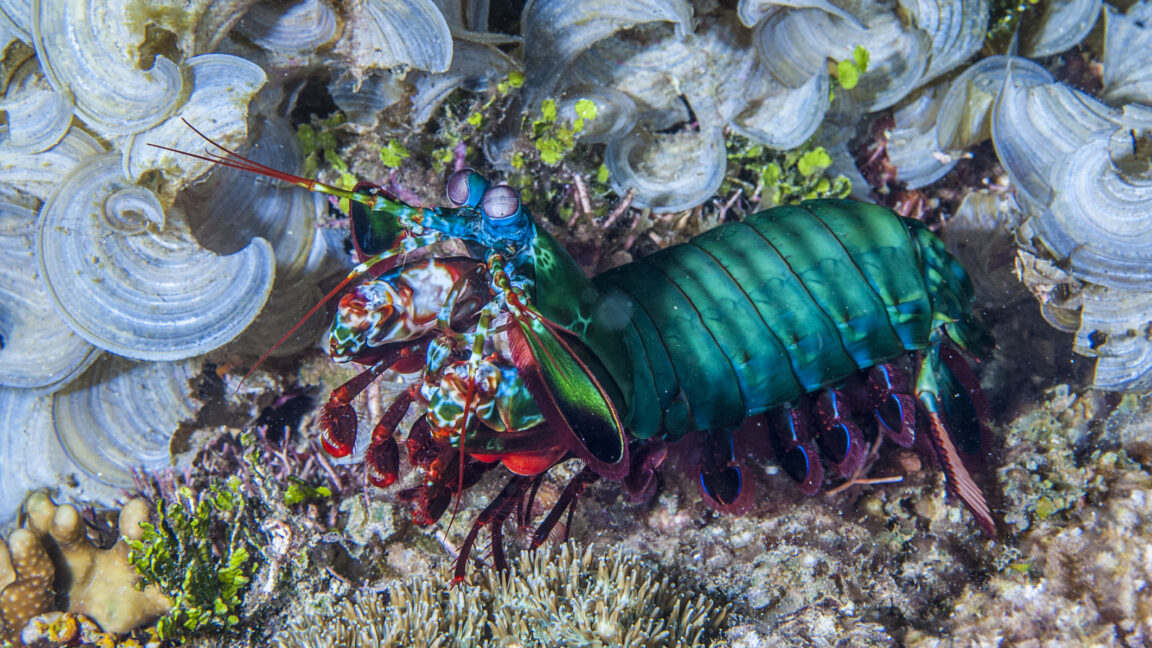
The seemingly indestructible fists of the mantis shrimp can take a punch
arstechnica.com
Pulling punches The seemingly indestructible fists of the mantis shrimp can take a punch Specialized structures in the animal's claws can seemingly absorb impact. Elizabeth Rayne Feb 22, 2025 7:00 am | 4 Credit: Giordano Cipriani Credit: Giordano Cipriani Story textSizeSmallStandardLargeWidth *StandardWideLinksStandardOrange* Subscribers only Learn moreThe mantis shrimp comes equipped with its own weapons. It has claws that look like permanently clenched fists that are known as dactyl clubs. But when it smashes the shells of its prey, these fists come out of it undamaged.When throwing punches, mantis shrimp can strike at the speed of a .22 caliber bullet (about 1,316 kmph or 818 mph)one of the fastest movements in the animal kingdom. That generates a force over a thousand times their body weight. However, unleashing that much energy can backfire because the shockwaves it produces could seriously damage an animals soft tissue. None of that seems to affect the mantis shrimp. Now we finally know why.When a team of researchers from Northwestern University studied the dactyl clubs of one mantis shrimp species, they found that they have layered structures that selectively block sound waves, acting as protective gear against vibrations that could otherwise harm the shrimp. These types of structures, known as phononic mechanisms, filter out sound waves that could otherwise cause nerve and soft tissue trauma.Together, these region-specific mechanisms form a synergistic protection system that withstands repeated high-intensity impacts without substantial damage, the researchers said in a study recently published in Science.Beyond body armorMantis shrimp are neither mantids nor shrimp. They are actually stomatopods, predatory marine crustaceans that first emerged 400 million years ago and feed on mollusks, fish, cnidarians and other crustaceans. The peacock mantis shrimp (Odontodactylus scyllarus) is one of the most formidable predators of the tropical shallows it hunts in.The Northwestern research team closely studied the dactyl clubs of one peacock mantis shrimp specimen and discovered three layers of phononic defenses. Phonons are units of vibrational energy that arise from atoms moving back and forth in a solid material. Phononic materials, like the shrimps defense mechanisms, are structured to manipulate sound waves that pass through them.When dissecting the clubs, the researchers found that they are covered in hydroxyapatite, a coating that also gives tooth enamel and bone their toughness. Beneath that coating is what they call the impact region, which consists of a chitin layer in a herringbone pattern (chitin is the hard, sugar-based material that makes up the animals shell). This particular structural form of chitin is thought to dissipate sound waves that could possibly cause cracking.Under the herringbone layer is what the researchers called the periodic region, made from layers of coiled chitin springs. The shrimp will draw back its dactyl clubs and then punch forward, releasing energy from the loaded springs to crack the shells of prey. These springs are made of chitin nanofibers layered in a twisted arrangement, which makes each structure appear much like an actual spring. These also manipulate the propagation of sound waves to both prevent breakage and protect nerves and soft tissues.Protecting yourself from yourselfMantis shrimp have to put up with incredibly intense blows, even though they are the ones who deal them. Their dactyl clubs swish through the water so fast that they create a temporary low-pressure area and form air bubbles in a process called cavitation. When those bubbles implode, they release light and heat energy so extreme that, for a fraction of a second, the water immediately surrounding the punch zone becomes as hot as the Sun. There may even be momentary flashes of light.To find out how much force a mantis shrimps dactyl clubs can possibly withstand, the researchers tested live shrimp by having them strike a piezoelectric sensor like they would smash a shell. They also fired ultrasonic and hypersonic lasers at pieces of dactyl clubs from their specimens so they could see how the clubs defended against sound waves.By tracking how sound waves propagated on the surface of the dactyl club, the researchers could determine which regions of the club diffused the most waves. It was the second layer, the impact surface, that handled the highest levels of stress. The periodic surface was almost as effective. Together, they made the dactyl clubs nearly immune to the stresses they generate.There are few other examples that the protective structures of the mantis shrimp can be compared to. On the prey side, evidence has been found that the scales on some moths wings absorb sound waves from predatory bats to keep them from echolocation to find them.Understanding how mantis shrimp defend themselves from extreme force could inspire new technology. The structures in their dactyl clubs could influence the designs of military and athletic protective gear in the future.Shrimp impacts contain frequencies in the ultrasonic range, which has led to shrimp-inspired solutions that point to ultrasonic filtering as a key [protective] mechanism, the team said in the same study.Maybe someday, a new bike helmet model might have been inspired by a creature that is no more than seven inches long but literally doesnt crack under pressure.Science, 2025. DOI: 10.1126/science.adq7100Elizabeth Rayne Elizabeth Rayne is a creature who writes. Her work has appeared on SYFY WIRE, Space.com, Live Science, Grunge, Den of Geek, and Forbidden Futures. She lurks right outside New York City with her parrot, Lestat. When not writing, she is either shapeshifting, drawing, or cosplaying as a character nobody has ever heard of. Follow her on Threads and Instagram @quothravenrayne. 4 Comments
0 Comments
·0 Shares
·29 Views









